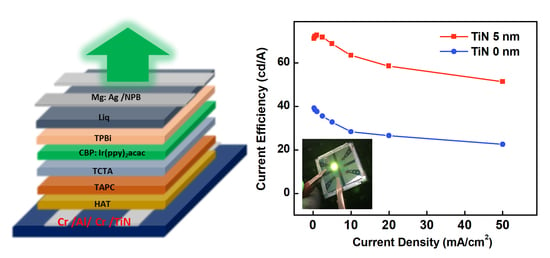Robust Laminated Anode with an Ultrathin Titanium Nitride Layer for High-Efficiency Top-Emitting Organic Light-Emitting Diodes
Abstract
:1. Introduction
2. Materials and Methods
3. Results and Discussion
4. Conclusions
Supplementary Materials
Author Contributions
Funding
Institutional Review Board Statement
Informed Consent Statement
Data Availability Statement
Acknowledgments
Conflicts of Interest
Sample Availability
References
- Joo, W.-J.; Kyoung, J.; Esfandyarpour, M.; Lee, S.-H.; Koo, H.; Song, S.; Kwon, Y.-N.; Song, S.H.; Bae, J.C.; Jo, A.; et al. Metasurface-driven OLED displays beyond 10,000 pixels per inch. Science 2020, 370, 459–463. [Google Scholar] [CrossRef] [PubMed]
- Hsiang, E.-L.; Yang, Z.; Yang, Q.; Lan, Y.-F.; Wu, S.-T. Prospects and challenges of mini-LED, OLED, and micro-LED displays. J. Soc. Inf. Display 2021, 29, 446–465. [Google Scholar] [CrossRef]
- Meng, W.; Xu, F.; Yu, Z.; Tao, T.; Shao, L.; Liu, L.; Li, T.; Wen, K.; Wang, J.; He, L.; et al. Three-dimensional monolithic micro-LED display driven by atomically thin transistor matrix. Nat. Nanotechnol. 2021, 16, 1231–1236. [Google Scholar] [CrossRef] [PubMed]
- Day, J.; Li, J.; Lie, D.Y.C.; Bradford, C.; Lin, J.Y.; Jiang, H.X. III-Nitride full-scale high-resolution microdisplays. Appl. Phys. Lett. 2011, 99, 031116. [Google Scholar]
- Liu, X.; Wu, Y.; Malhotra, Y.; Sun, Y.; Ra, Y.-H.; Wang, R.; Stevenson, M.; Coe-Sullivan, S.; Mi, Z. Submicron full-color LED pixels for microdisplays and micro-LED main displays. J. Soc. Inf. Display 2020, 28, 410–417. [Google Scholar] [CrossRef]
- Choi, H.W.; Jeon, C.W.; Dawson, M.D. High-resolution 128 × 96 nitride microdisplay. IEEE Electron Device Lett. 2004, 25, 277–279. [Google Scholar] [CrossRef]
- Vettese, D. Liquid crystal on silicon. Nat. Photon. 2010, 4, 752–754. [Google Scholar] [CrossRef]
- Huang, H.-C.; Zhang, B.; Peng, H.; Kwok, H.-S.; Cheng, P.-W.; Chen, Y.-C. Processes, characterizations, and system applications of color-filter liquid-crystal-on-silicon microdisplays. J. Soc. Inf. Disp. 2006, 14, 499–508. [Google Scholar] [CrossRef]
- Kim, S.S.; Berkeley, B.H.; Park, J.H.; Kim, T. New era for TFT-LCD size and viewing-angle performance. J. Soc. Inf. Disp. 2006, 14, 127–134. [Google Scholar] [CrossRef]
- Xie, G.; Xue, Q.; Chen, P.; Tao, C.; Zhao, C.; Lu, J.; Gong, Z.; Zhang, T.; Huang, R.; Du, H.; et al. Highly efficient and low-cost top-emitting organic light-emitting diodes for monochromatic microdisplays. Org. Electron. 2010, 11, 407–411. [Google Scholar] [CrossRef]
- Teng, D.; Xiong, Y.; Liu, L.; Wang, B. Multiview three-dimensional display with continuous motion parallax through planar aligned OLED microdisplays. Opt. Express 2015, 23, 6007–6019. [Google Scholar] [CrossRef] [PubMed]
- Ventsch, F.; Gather, M.C.; Meerholz, K. Towards organic light-emitting diode microdisplays with sub-pixel patterning. Org. Electron. 2010, 11, 57–61. [Google Scholar] [CrossRef]
- Fujii, T.; Kon, C.; Motoyama, Y.; Shimizu, K.; Shimayama, T.; Yamazaki, T.; Kato, T.; Sakai, S.; Hashikaki, K.; Tanaka, K.; et al. 4032 ppi High-resolution OLED microdisplay. J. Soc. Info. Display 2018, 26, 178–186. [Google Scholar] [CrossRef]
- Zhao, B.; Huang, R.; Ma, F.; Xie, G.; Zhang, Z.; Du, H.; Luo, J.; Zhao, Y. The realization of an SVGA OLED-on-silicon microdisplay driving circuit. J. Semicond. 2012, 33, 035006. [Google Scholar] [CrossRef]
- Kelly, G.; Woodburn, R.; Underwood, I.; Burns, D.; Monteith, R.; Newsam, M.; Parmiter, P.; Arslan, T. A full-color QVGA microdisplay using light-emitting-polymer on CMOS. In Proceedings of the 13th IEEE International Conference on Electronics, Circuits and Systems, Nice, France, 10–13 December 2006; pp. 760–763. [Google Scholar]
- Chen, C.-W.; Hsieh, P.-Y.; Chiang, H.-H.; Lin, C.-L.; Wu, H.-M.; Wu, C.-C. Top-emitting organic light-emitting devices using surface-modified Ag anode. Appl. Phys. Lett. 2003, 83, 5127–5129. [Google Scholar] [CrossRef]
- Lee, J.-J.; Li, P.; Kung, H.-T.; Lu, Z.-H. Highly efficient top-emission organic light-emitting diode on an oxidized aluminum anode. J. Appl. Phys. 2019, 125, 145501. [Google Scholar] [CrossRef]
- Xue, Q.; Xie, G. Easily reproducible top-emitting organic light-emitting devices for microdisplays adapted to aluminum contact from the standard CMOS processes. J. Inf. Display 2020, 21, 131–137. [Google Scholar] [CrossRef]
- Lee, H.; Cho, H.; Byun, C.-W.; Kang, C.-M.; Han, J.-H.; Lee, J.-I.; Kim, H.; Lee, J.H.; Kim, M.; Cho, N.S. Device characteristics of top-emitting organic light-emitting diodes depending on anode materials for CMOS-based OLED microdisplays. IEEE Photonics J. 2018, 10, 1–9. [Google Scholar] [CrossRef]
- Ji, Y.; Ran, F.; Xu, H.; Shen, W.; Zhang, J. Improved performance and low-cost OLED microdisplay with titanium nitride anode. Org. Electron. 2014, 15, 3137–3143. [Google Scholar] [CrossRef]
- Xiao, B.; Yao, B.; Ma, C.; Liu, S.; Xie, Z.; Wang, L. Highly efficient top-emitting organic light-emitting devices with aluminium electrodes. Semicond. Sci. Technol. 2005, 20, 952–955. [Google Scholar] [CrossRef]
- Min, S.H.; Kim, C.K.; Moon, D.G. Flexible top emission organic light emitting diodes with Ni and Au anodes deposited on a cellulose paper substrate. Mol. Cryst. Liq. Cryst. 2013, 584, 27–36. [Google Scholar] [CrossRef]
- Choi, H.W.; Kim, S.Y.; Choi, H.W.; Kim, S.Y.; Lee, J.-L. Enhancement of hole injection using O2 plasma-treated Ag anode for top-emitting organic light-emitting diodes. Appl. Phys. Lett. 2005, 86, 012104. [Google Scholar] [CrossRef]
- Cao, J.; Jiang, X.Y.; Zhang, Z.L. MoOx modified Ag anode for top-emitting organic light-emitting devices. Appl. Phys. Lett. 2006, 89, 252108. [Google Scholar] [CrossRef]
- Chong, L.-W.; Lee, Y.L.; Wen, T.-C.; Guo, T.-F. Self-assembled monolayer-modified Ag anode for top-emitting polymer light-emitting diodes. Appl. Phys. Lett. 2006, 89, 233513. [Google Scholar] [CrossRef]
- Adamovich, V.; Shoustikov, A.; Thompson, M.E. TiN as an anode material for organic light-emitting diodes. Adv. Mater. 1999, 11, 727–730. [Google Scholar] [CrossRef]
- Cheng, H.-E.; Chiang, M.-J.; Hon, M.-H. Growth characteristics and properties of TiN coating by chemical vapor deposition. J. Electrochem. Soc. 1995, 142, 1573. [Google Scholar] [CrossRef]
- Musher, J.N.; Gordon, R.G. Low-temperature CVD TiN as a diffusion barrier between gold and silicon. J. Electron. Mater. 1991, 20, 1105–1107. [Google Scholar] [CrossRef]
- Chung, S.M.; Hwang, C.S.; Lee, J.I.; Park, S.H.K. Enhancement of luminance characteristics in top-emission organic light emitting diode with Cr/Al/Cr anodes. Jpn. J. Appl. Phys. 2007, 46, 3618–3621. [Google Scholar] [CrossRef]
- Chung, S.M.; Hwang, C.S.; Lee, J.I.; Hee, S.; Park, S.H.K.; Lee, M.D.; Chu, H.Y. Top emission organic light emitting diode with a Cr/Al/Cr anode. Synthetic. Met. 2007, 157, 327–331. [Google Scholar] [CrossRef]
- Qian, M.; Shi, X.-B.; Ma, J.; Liang, J.; Liu, Y.; Wang, Z.-K.; Liao, L.-S. A stacked Al/Ag anode for short circuit protection in ITO free top-emitting organic light-emitting diodes. RSC Adv. 2015, 5, 96478. [Google Scholar] [CrossRef]
- Kötz, E.R.; Neff, H.; Müller, K. A UPS, XPS and work function study of emersed silver, platinum and gold electrodes. J. Electroanaly. Chem. Interfacial Electrochem. 1986, 215, 331–344. [Google Scholar] [CrossRef]
- Helander, M.G.; Wang, Z.B.; Qiu, J.; Greiner, M.T.; Puzzo, D.P.; Liu, Z.W.; Lu, Z.H. Chlorinated indium tin oxide electrodes with high work function for organic device compatibility. Science 2011, 332, 944–947. [Google Scholar] [CrossRef]
- Park, Y.; Choong, V.; Gao, Y.; Hsieh, B.R.; Tang, C.W. Work function of indium tin oxide transparent conductor measured by photoelectron spectroscopy. Appl. Phys. Lett. 1996, 68, 2699–2701. [Google Scholar] [CrossRef]
- Swayamprabha, S.S.; Nagar, M.R.; Yadav, R.A.K.; Gull, S.; Dubey, D.K.; Jou, J.H. Hole-transporting materials for organic light-emitting diodes: An overview. J. Mater. Chem. C 2019, 7, 7144–7158. [Google Scholar]
- Jhulki, S.; Moorthy, J.N. Small molecular hole-transporting materials (HTMs) in organic light-emitting diodes (OLEDs): Structural diversity and classification. J. Mater. Chem. C 2018, 6, 8280–8325. [Google Scholar] [CrossRef]
- Juang, F.S.; Patel, K.D.; Huang, K.C.; Juang, W.X.; Chen, J.X.; Hong, L.A. The section of anode and cathode materials for top emission organic light-emitting diodes. Int. J. Photoenergy 2022, 10, 6401932. [Google Scholar]
- Hofmann, S.; Thomschke, M.; Lüssem, B.; Leo, K. Top-emitting organic light-emitting diodes. Opt. Express 2011, 19, A1250–A1264. [Google Scholar] [CrossRef]
- Jordan, R.H.; Rothberg, L.J.; Dodabalapur, A.; Slusher, R.E. Efficiency enhancement of microcavity organic light emitting diodes. Appl. Phys. Lett. 1996, 69, 1997–1999. [Google Scholar] [CrossRef]
- Hu, S.; Zeng, J.J.; Zhu, X.Y.; Guo, J.J.; Chen, S.; Zhao, Z.J.; Tang, B.Z. Universal bipolar host materials for blue, green, and red phosphorescent OLEDs with excellent efficiencies and small-efficiency roll-off. ACS. Appl. Mater. Interfaces. 2019, 11, 27134–27144. [Google Scholar] [CrossRef]
- Swensen, J.S.; Polikarpov, E.; Von Ruden, A.; Wang, L.; Sapochak, L.S.; Padmaperuma, A.B. Improved efficiency in blue phosphorescent organic light-emitting devices using host materials of lower triplet energy than the phosphorescent blue emitter. Adv. Funct. Mater. 2011, 21, 3250–3258. [Google Scholar] [CrossRef]
- Peng, H.; Sun, J.; Zhu, X.; Yu, X.; Wong, M.; Kwok, H.S. High-efficiency microcavity top-emitting organic light-emitting diodes using silver anode. Appl. Phys. Lett. 2006, 88, 073517. [Google Scholar] [CrossRef]
- Kim, N.S.; Kim, D.Y.; Song, J.H.; Suh, M.C. Improvement of viewing angle dependence of bottom-emitting green organic light-emitting diodes with a strong microcavity effect. Opt. Express 2020, 28, 31686–31699. [Google Scholar] [CrossRef] [PubMed]
- Rogers, T.J.; Deppe, D.G.; Streetman, B.G. Effect of an AlAs/GaAs mirror on the spontaneous emission of an InGaAs-GaAs quantum well. Appl. Phys. Lett. 1990, 57, 1858–1860. [Google Scholar] [CrossRef]
- Schubert, E.F.; Hunt, N.E.J.; Micovic, M.; Malik, R.J.; Sivco, D.L.; Cho, A.Y.; Zydzik, G.J. Highly efficient light-emitting diodes with microcavities. Science 1994, 265, 943–945. [Google Scholar] [CrossRef] [PubMed]
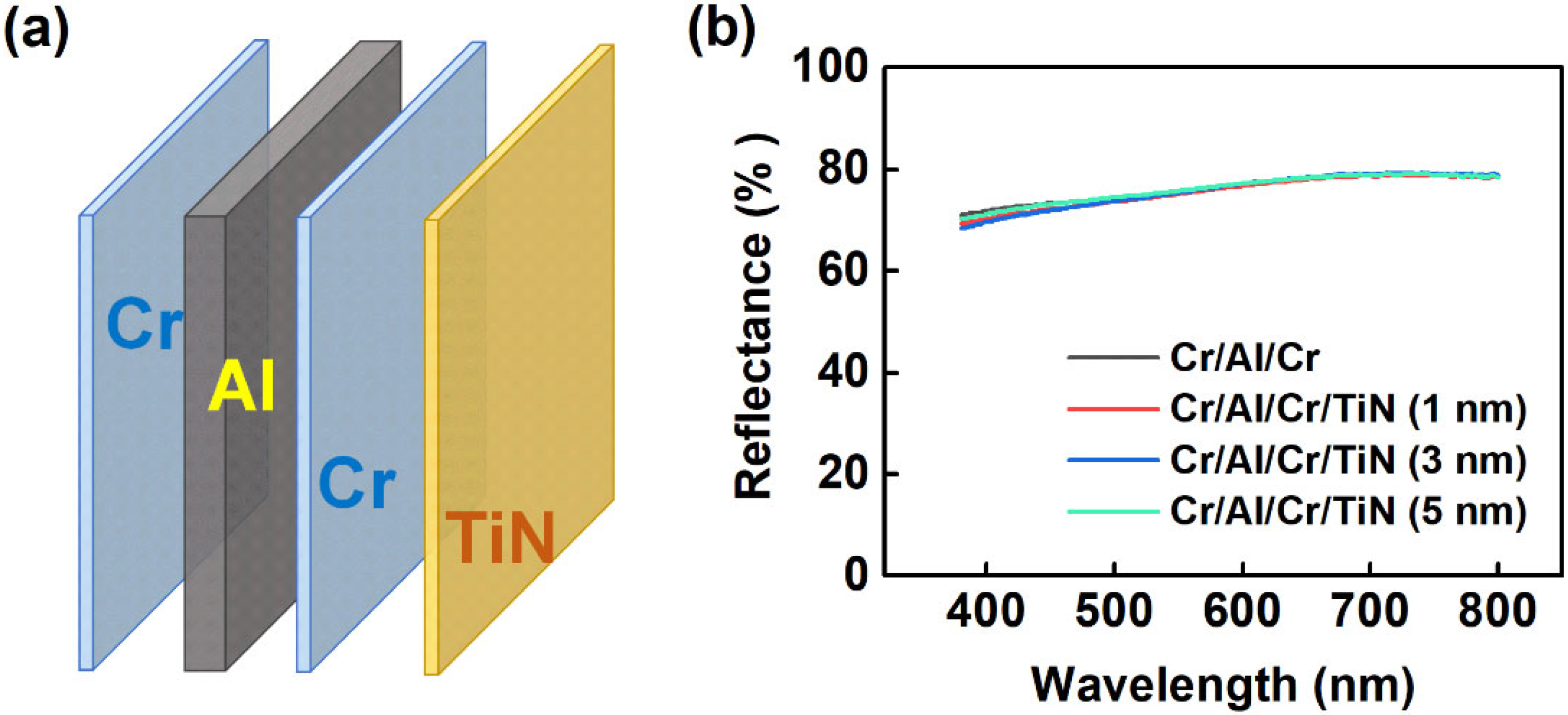
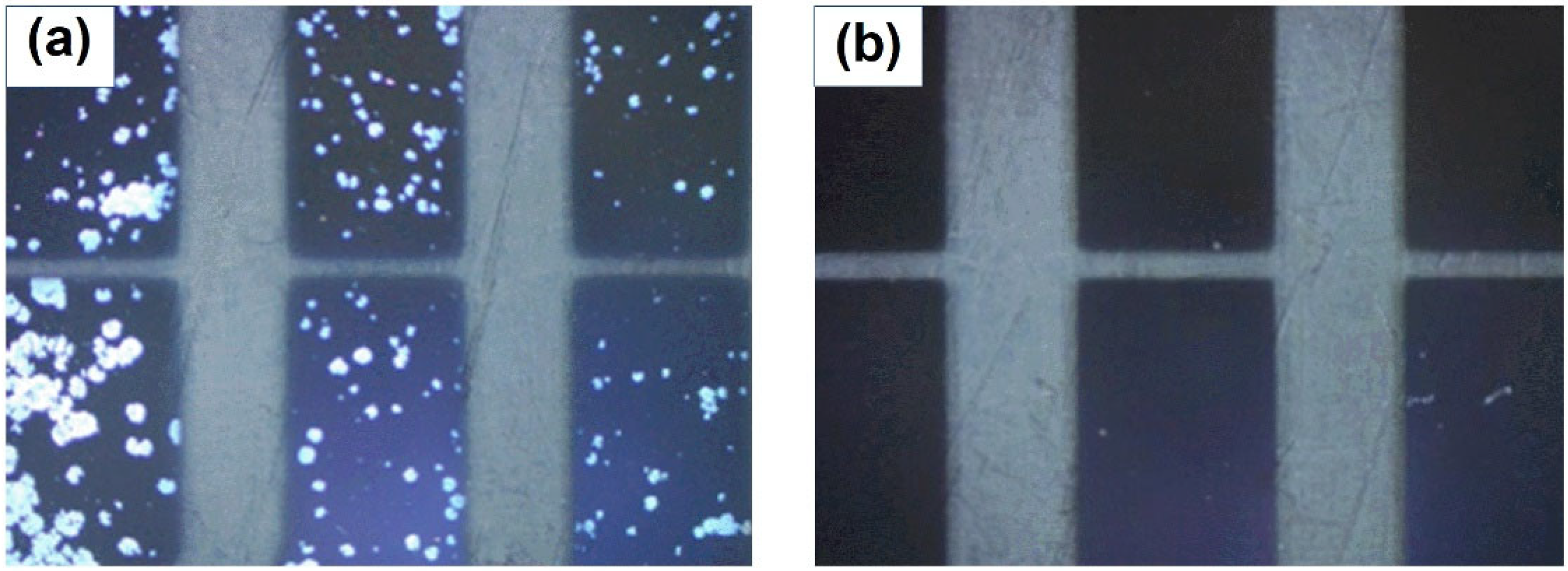
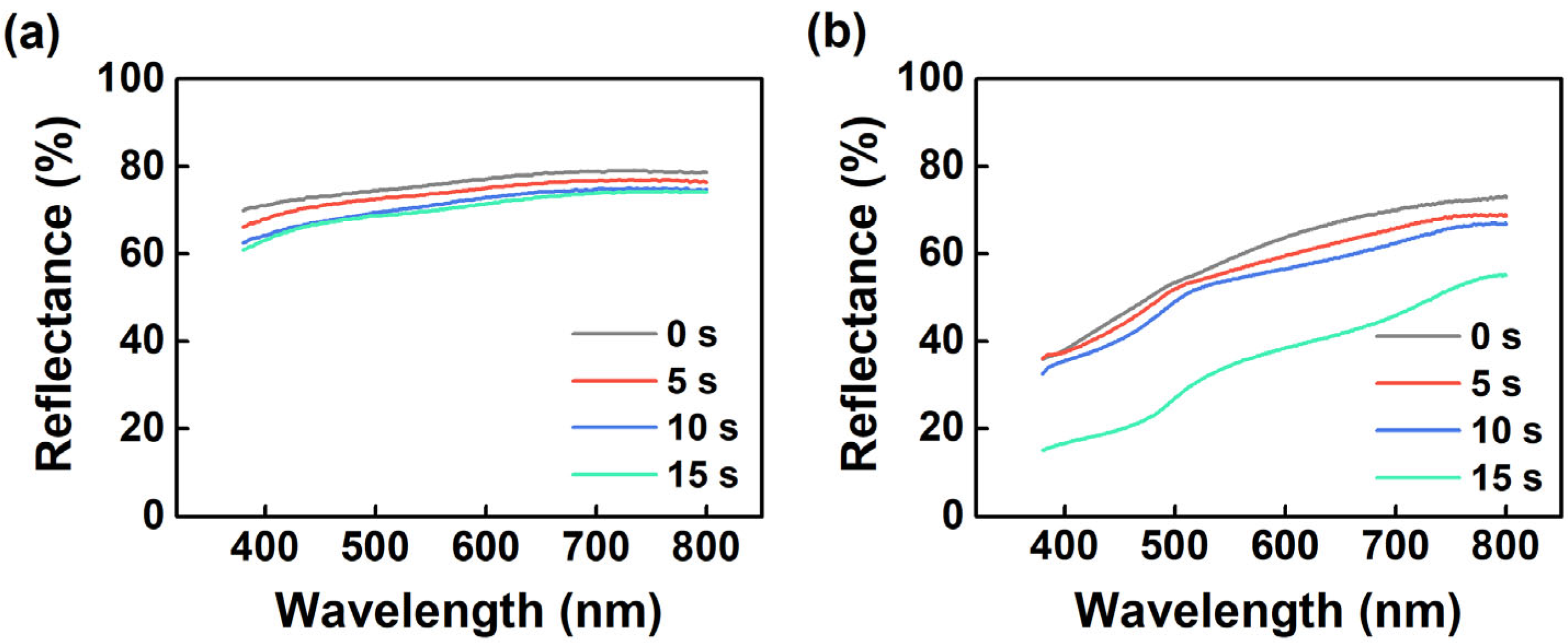
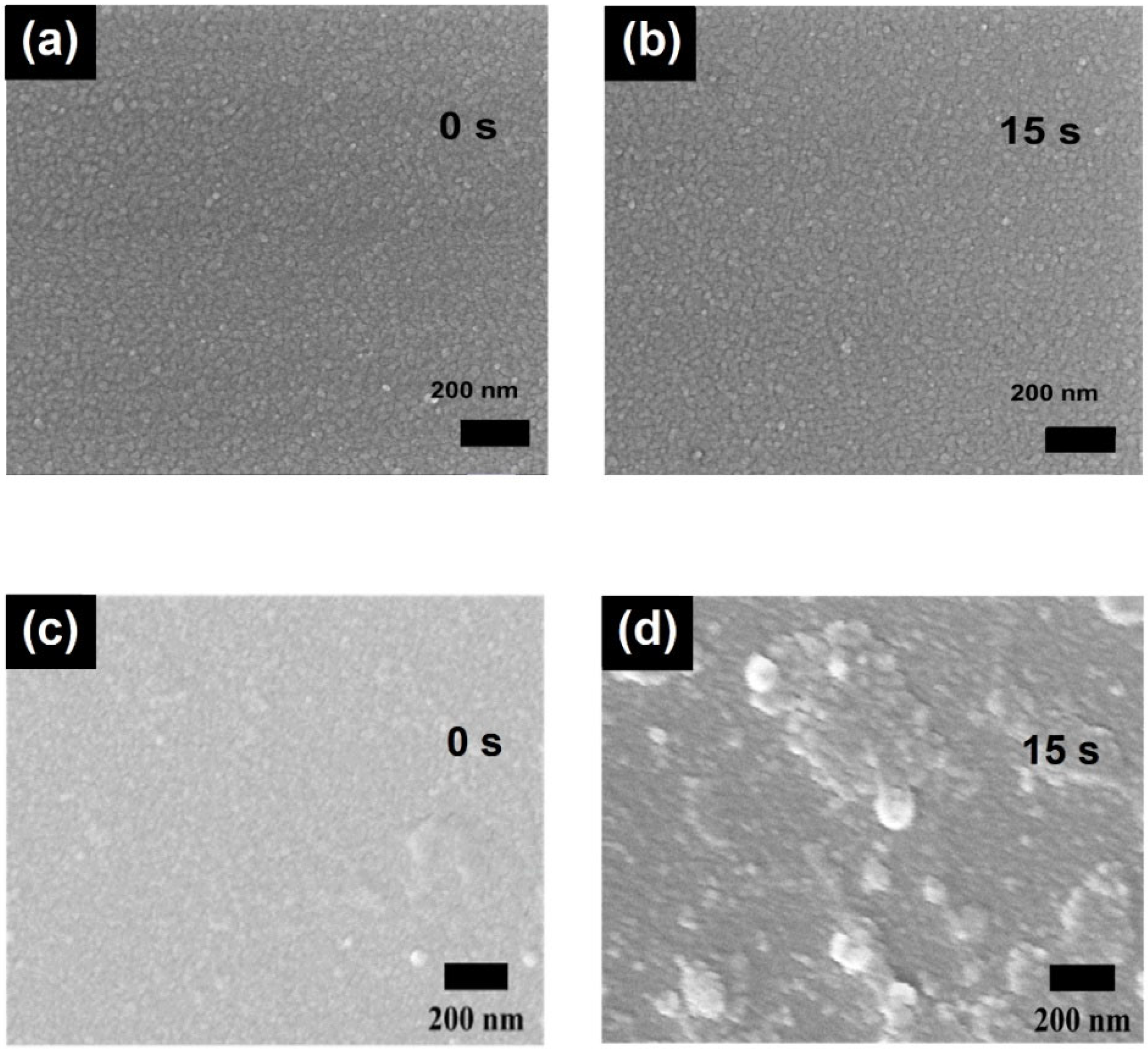
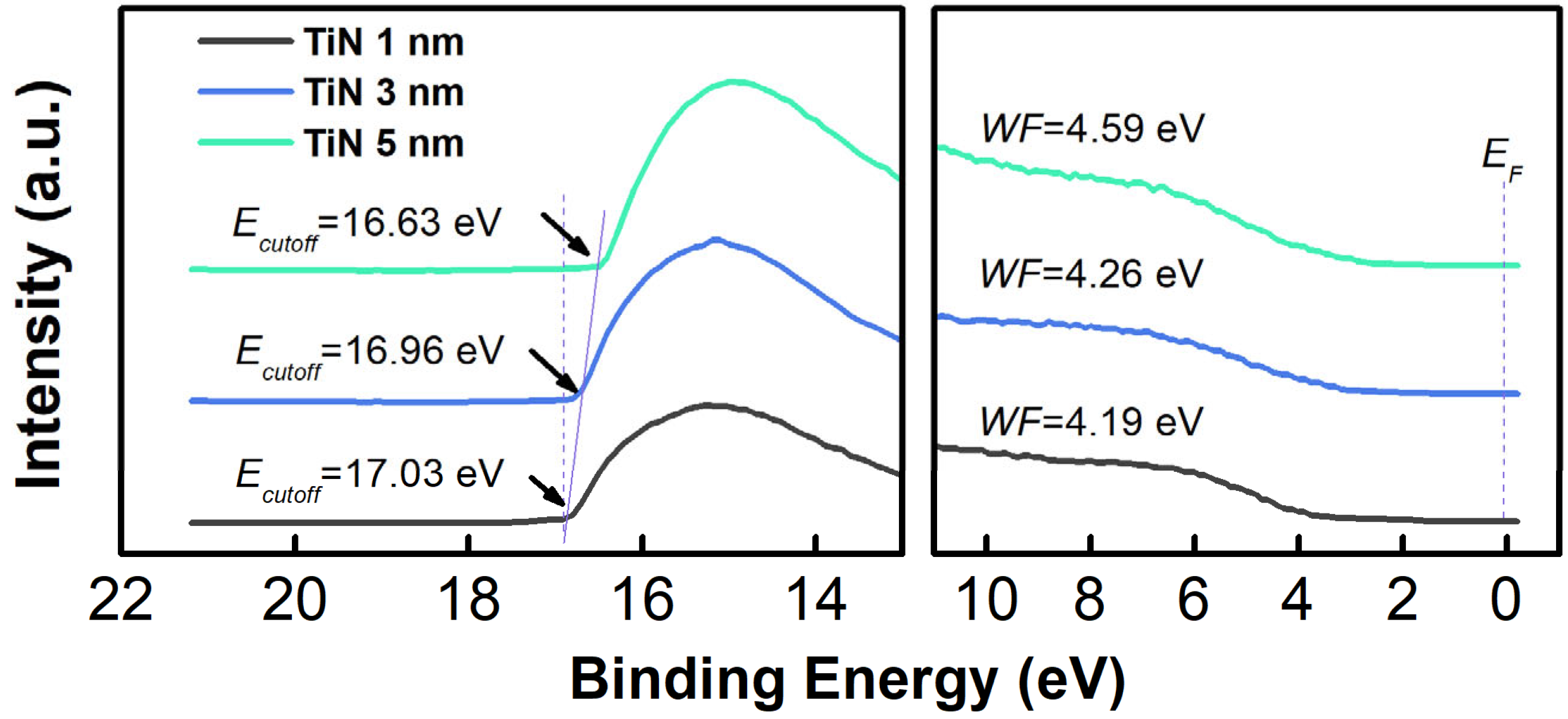


| Sample | Sheet Resistance after Treating for Different Times (Ω/□) | |||
|---|---|---|---|---|
| 0 s | 5 s | 10 s | 15 s | |
| Cr/Al/Cr/TiN | 8.8 | 9.0 | 9.2 | 11.2 |
| Cr/Al/Cr/Mo | 3.4 | 5.4 | 7.6 | 7.7 |
Publisher’s Note: MDPI stays neutral with regard to jurisdictional claims in published maps and institutional affiliations. |
© 2022 by the authors. Licensee MDPI, Basel, Switzerland. This article is an open access article distributed under the terms and conditions of the Creative Commons Attribution (CC BY) license (https://creativecommons.org/licenses/by/4.0/).
Share and Cite
Cai, J.-H.; Tian, Q.-S.; Zhu, X.-Z.; Qu, Z.-H.; He, W.; Zhou, D.-Y.; Liao, L.-S. Robust Laminated Anode with an Ultrathin Titanium Nitride Layer for High-Efficiency Top-Emitting Organic Light-Emitting Diodes. Molecules 2022, 27, 5723. https://doi.org/10.3390/molecules27175723
Cai J-H, Tian Q-S, Zhu X-Z, Qu Z-H, He W, Zhou D-Y, Liao L-S. Robust Laminated Anode with an Ultrathin Titanium Nitride Layer for High-Efficiency Top-Emitting Organic Light-Emitting Diodes. Molecules. 2022; 27(17):5723. https://doi.org/10.3390/molecules27175723
Chicago/Turabian StyleCai, Jia-Heng, Qi-Sheng Tian, Xiao-Zhao Zhu, Zhi-Hao Qu, Wei He, Dong-Ying Zhou, and Liang-Sheng Liao. 2022. "Robust Laminated Anode with an Ultrathin Titanium Nitride Layer for High-Efficiency Top-Emitting Organic Light-Emitting Diodes" Molecules 27, no. 17: 5723. https://doi.org/10.3390/molecules27175723





